If you are new to Paris and wish to see the city sights,
but need a rest the Canal St Martin, Paris South Bank.
is the place to go for a break from the city’s tourist frenzy.
If you are a canal-a-holic it’s a must.
In canal terms it is the Paris equivalent of London’s
Regents Canal. Not as intimate but still interesting.
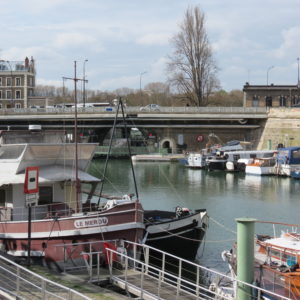 It’s an ideal place to have a quiet Sunday morning pavement
It’s an ideal place to have a quiet Sunday morning pavement
breakfast or just a walk by the water or over the top of its tunnel.
The Canal St Martin is only about 4 miles long and was built
between 1802 to 1825 on the orders of Napoleon.
The principal reason for its construction was to bring fresh water into the
city to supply an expanding urban population and mitigate the problems
of disease which had become common in Paris by the 18th Century.
It was also used to supply the city with food and building materials.
The Canal St Martin had two principal ports, the Bassin de la Arsenal
(south) and the Bassin de la Villette (north).
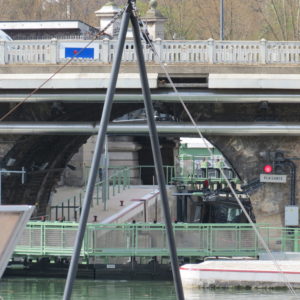
At the southern end of the canal an exit lock under the main Henry IV
Roadway (just down the river from Notre Dame) drops boats out of the
Bassin de Arsenal down into the river Seine adjacent to Port Henry IV.
This is the base for many river trip boats and provides the best
waterside pedestrian access to this section of canal.
It is also adjacent to Metro Station.(M) Qual de la Rapee.
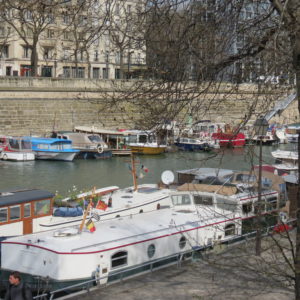
The Bassin de Arsenal was the canals original principal port for Paris,
but during the 1960’s trade fell away dramatically and the whole
Canal St Martin was threatened with closure and conversion to a road.
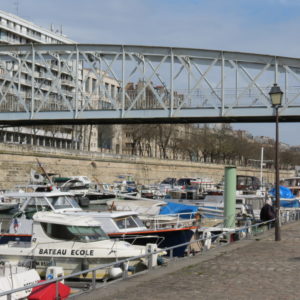
In 1983 the Basin de Arsenal was converted to a marina and is now
home to about 180 smaller canal craft and many sea going motor boats.
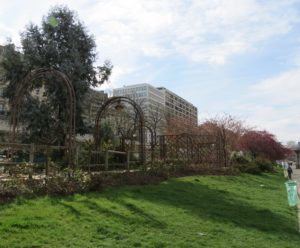
The Arsenal section is the only part of the canal which is in a cutting and
at the opposite end from the Seine Lock, part of the old dockside has now
been planted as community gardens and contains a small children’s play area.

This is also the location for boarding the Canal St Martin trip boat which
descends under the site of the Bastille which is now marked by this
copper clad column. (M Bastille)
The tunnel is approximately 2000 yes long.
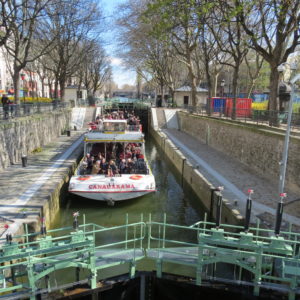
Staircase Lock at Rue Eugene Varlin
The canal had only just been reopened after having a good clean out
and this was the first trip boat to pass through the locks after reopening.
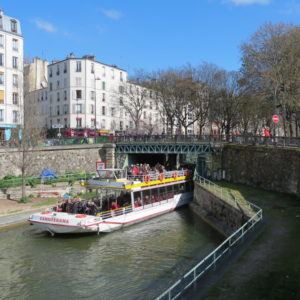
11 of us bundled into the back room of Cafe Pomm
on the left, adjacent to the lock for a Crepe breakfast.
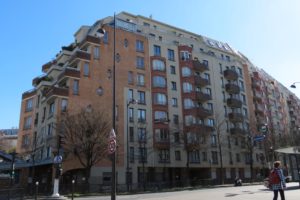
Most of the canal runs through 1960’s mundane working
class housing. This Art Deco block adjacent to the lock, while
not outstanding, does provide some interest above eye level.

Like the Regent’s in Maida Vale the Canal St Martin runs between urban streets,
but unlike its counterpart, there are no iron railings between road and water.
On our visit the streets were lined with locals sat at small cafes,
eateries and bars enjoying the morning sunshine.
Locals also sat picnicking on the grassy canal banks.
On a Sunday the roadways are closed to traffic and are
filled with Parisian walkers ,joggers, and dog walkers.
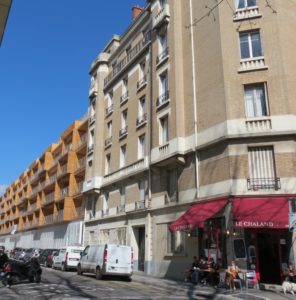
It didn’t take long to find evidence that this working class part of
the Paris South Bank is about to morph into a YUPPY enclave
as most of the slums adjacent to the Regents did in the 1960’s
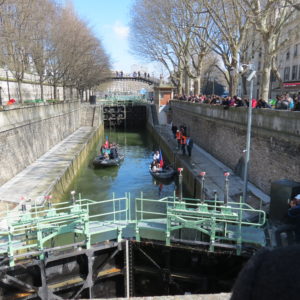
At the north end of the canal we came across this filming session
in the locks at Rue la Fayette (M Jaures) which lifts boats up
to the end of the Canal St Martin and into the Bassin de la Villette.
No idea if it was intended to publicise the reopening of the canal.
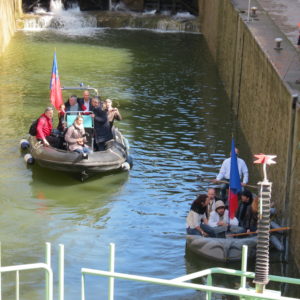
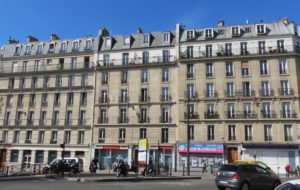
By this time the housing just below the lock had changed from
modern flats to terraces of more traditional Parisian apartments.
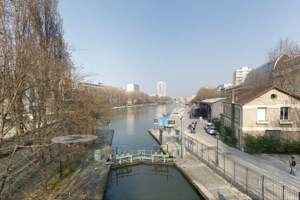
The Bassin de la Villette to which the Rue la Fayette Locks lead.
The Basin at 900 yds x 70 yds is the largest lake in Paris. It was built
as a Port a Reservoir and as a connection between the Canal St Denis
the Canal St Martin and the Canal de l’Ounrcq which supplied water
from the river Ourcq about 100 miles away.
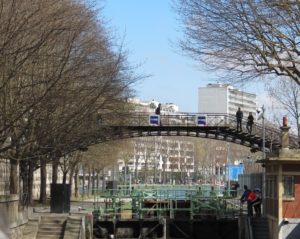
No trip to the Canal St Martin, Paris. would be complete without a photo
of one of its almost unique foot bridges, in this case the bridge over the
locks from which the above photo was taken.
Au Revoir